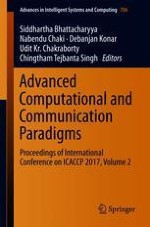2018 | OriginalPaper | Chapter
Improved Decision-Making for Navigation Scenarios
Authors : Khyati Marwah, J. S. Sohal
Published in: Advanced Computational and Communication Paradigms
Publisher: Springer Singapore
Activate our intelligent search to find suitable subject content or patents.
Select sections of text to find matching patents with Artificial Intelligence. powered by
Select sections of text to find additional relevant content using AI-assisted search. powered by
